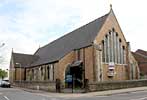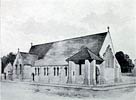 Sutton-in-Ashfield Sutton-in-Ashfield
St Michael and All Angels
History
St Michael and All Angels is a Victorian church built in a replica style of the Early English of the medieval period.
Work begun in 1886 and was not completed until 1910 because of the lack of funds.
It was the first Anglican church to be built after the parish church, St Mary’s, in Sutton-in-Ashfield (although see St Modwen's which began life in a school in 1879).
A site for the church was purchased from Mr W. Straw, with enough land to build a vicarage and schools. The foundation stones of the church were laid on 6 October 1886, although the ceremony was shortened by the downpour of rain. Mr. W. Unwin Heathcote laid the first foundation stone, and was presented with a silver trowel with an ivory handle, and an inscription for the occasion. The Rev. F. Brodhurst (the vicar of Sutton-in-Ashfield) conducted the service and the clergy present were Canon Pavey (Mansfield), the Rev C. C. Naters (Mansfield), the Rev. T. Marsh (St Modwen’s, Sutton), the Rev. W. J. Whitwell (Sutton), the Rev. F. J. Taverner (Skegby) and the Rev. H. A. K. Hawkins (Hucknall Huthwaite).
Initially the church consisted of a chancel, vestry, and organ chamber with accommodation for 250 people. The architect was James Fowler of Louth and Morgan and Cooper of Kempsall were the masons, with a contract of £1,505. At the start of construction, around £1,500 had already been raised, though other costs had to be taken into account. Fortunately, the Duke of Portland donated the stone, along with a subscription of £100. The subscription list also contained the late Mr W. Billson, £500; subscriptions collected by the Rev. C. E. Laing and the Rev. F. J. Clarke (late curates-in-charge), £240; the Marshall Trustees, £200; the Bishop of Southwell, £50; Mr G. G. Bonser, £50; Mr A. H. Bonser, £50; the Church Building Society (first grant), £40 and a number of other contributors.
The church was opened by Dr George Ridding, the Bishop of Southwell, on 28 September 1887. At the service, there was a large congregation with a considerable number of clergy. A sermon was preached by the bishop from St Luke ii., 13, 14: ‘And suddenly there was with the angel a multitude of the heavenly host, praising God and saying, Glory to God in the highest, and on earth peace, goodwill towards men’.
Even when first opened, the church was quite large, with two windows in the northern end. It was built to be relatively lofty, with carved corbels. The chancel consisted of three bays, where the windows stood at a height from the ground. The roof of the chancel was boarded and divided into panels. On the north side was an arch leading through to the vestry and organ chamber. The east window had five divisions of varying widths. The floors were embedded with encaustic and plain tiles in an appealing pattern, with the sanctuary raised five steps above the nave. There was no fixed furniture initially except for the altar and altar rails made of English oak, supplied by Jones and Willis, Birmingham. The offertories at the opening of the ceremony were devoted to furnishing the church.
 Architect's drawing of the Architect's drawing of the
proposed nave (1908) |
A corrugated iron nave with seating accommodation of 300 was added in 1892. However, by 1908 this was proving inadequate and plans were made to build a stone nave with north and south aisles to accommodate a congregation of 650. The nave was designed by the London architect, Louis Ambler, and constructed in 1909.
St Michael and All Angels was formed into an ecclesiastical parish by Order in Council on 25 October 1910. By this time, the total cost of building the church was £7,000. The total sittings became 650. A church hall was erected in 1926 adjoining the church.
The Rev. W. H. C. Stainer reported in 1912 that there were 10,000 people in his parish, and 600 children on the roll of the Sunday School.
In the mid-late 20th century, the building was endangered by subsidence. For a while the whole inner church was enveloped in scaffolding. From around 1969-72, work was undertaken by the congregation to improve the interior and complete the furnishings more fashionably.
A Flower Festival was held in 1971 which was suited to the large space. Displays were shown on an unusual scale with special lighting installed for the following year to allow arrangements to be shown at their best advantage. The building was exceptional for the performance of music. Some repairs to the organ were carried out by Midland Organ-builders (Nottingham) in 1972 when the old instrument fell into disrepair. Another Flower Festival was carried out in the latter year with the organist Lionel Rogg and chorister Nicolas Kynaston, both of whom have a good reputation for their work.
The living is a vicarage with a net yearly value of £200 in 1912, though without residence at this time. It was endowed by the Ecclesiastical Commissioners in the gift of the Bishop of Southwell. It was held by the Rev. William Clement Stainer, B.A. of London University, from 1910 to 1923. In 1928, the yearly value was £290, and held by the Rev. Julian Millet until 1934, when it was then held by the Rev. George Sprittles.
The church was made redundant in 2003 and was put up for sale. It is currently (2017) occupied by the Sanctuary Gaming Centre.
The register of baptisms dates from the year 1903, while marriages start from 1910.
| 


 Architect's drawing of the
Architect's drawing of the 





